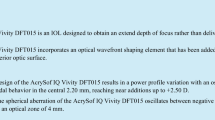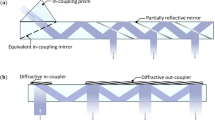Abstract
Fundamental requirements for optical system design for volume recording system is identified. Anastigmatic objective lens design is required for conventional page-based system, whereas for multi-layer volume recording systems, an Aplanatic and zoom optical design is needed with an afocal sub-optical system including a high numerical aperture (NA) objective element. An NA 0.4 and four element design is feasible by only using off-the-shelf components. Recording depth ranges of 0.4 mm for wavelength 532 nm and 0.2 mm for 405 nm. The design demonstrates sufficiently small as-built wavefront error, less than 0.1 waves while implementing focusing and tracking capabilities to the design.
Similar content being viewed by others
References
Ashton K. That ‘internet of things’ thing: in the real world things matter more than ideas. RFID Journal, 2009, 22: 97–114
McLeod R R, Daiber A J, McDonald M E, Robertson T L, Slagle T, Sochava S L, Hesselink L. Microholographic multilayer optical disk data storage. Applied Optics, 2005, 44(16): 3197–3207
Takashima Y, Hesselink L. Design and tolerance of numerical aperture 0.8 objective lenses for page-based holographic data storage systems. Japanese Journal of Applied Physics, 2009, 48(3S1): 03A004
Neifeld M A, McDonald M. Lens-design issues affecting parallel readout of optical disks. Applied Optics, 1995, 34(23): 5167–5174
Neifeld M A, McDonald M. Lens design issues impacting page access to volume optical media. Optics Communications, 1995, 120(1–2): 8–14
Zeng J Y, Wang M Q, Yan Y B, He Q S, Jin G F. Design of a short-focal-length double-Fourier-transform-lens system for holographic storage. Optical Engineering (Redondo Beach, Calif.), 2007, 46(3): 033002-1–033002-7
Kubota S. Aplanatic condition required to reproduce jitter-free signals in an optical digital disk system. Applied Optics, 1987, 26(18): 3961–3973
Stallinga S. Compact description of substrate-related aberrations in high numerical-aperture optical disk readout. Applied Optics, 2005, 44(6): 849–858
Barbastathis G, Psaltis D. Volume Holographic Multiplexing Methods. In: Coufal H J, Psaltis D, Sincerbox G T, eds. Holographic Data Storage. Springer Berlin Heidelberg: Springer, 2000, 21–62
von Bieren K. Lens design for optical fourier transform systems. Applied Optics, 1971, 10(12): 2739–2742
Orlov S S, Phillips W, Bjornson E, Takashima Y, Sundaram P, Hesselink L, Okas R, Kwan D, Snyder R. High-transfer-rate high-capacity holographic disk data-storage system. Applied Optics, 2004, 43(25): 4902–4914
Wynne C G. Primary aberrations and conjugate change. Proceedings of the Physical Society, 1952, 65(6): 429–437
Matsui Y, Nariai K. Fundamentals of Practical Aberration Theory: Fundamental Knowledge and Techniques for Optical Designers. New Jersey: World Scientific, 1993
Milster T D, Upton R S, Luo H. Objective lens design for multiplelayer optical data storage. Optical Engineering (Redondo Beach, Calif.), 1999, 38(2): 295–301
Eichler H J, Kuemmel P, Orlic S, Wappelt A. High-density disk storage by multiplexed microholograms. IEEE Journal on Selected Topics in Quantum Electronics, 1998, 4(5): 840–848
Shi X, Ostroverkhov V, Lawrence B, Boden E, Ren Z, Takashima Y, Ross F. Micro-holographic data storage: materials and systems. Review of Laser Engineering, 2010, 38: 349–355
Author information
Authors and Affiliations
Corresponding author
Additional information
Yuzuru Takashima is an Associate Professor at College of Optical Sciences of University of Arizona and has been on the faculty since 2011. He teaches one of the core courses: Lens Design for undergraduates and Optical Design for Multi-scale Photonic System for graduate students. Prior to joining to the University of Arizona, he was employed as a research staff by Stanford University, where he has been actively involved in the field of novel optical system design and engineering, particularly for high density page-based and bit-based holographic data storage systems and Nano-photonic electron beam generators. He was employed as an optical engineer at Toshiba Corporation in Japan, where he conducted research and development of ultra-precision manufacturing of optical components and products. He received his B.S. degree in Physics from Kyoto University (1990) and M.S. (2004) and Ph.D. degrees in Electrical Engineering from Stanford University in 2007. His current research includes X-ray optical system design, environmentally robust holographic data storage system, maskbased and mask-less hybrid lithography for 3D optical interconnects, novel alignment process for lithography, ultra-thin form factor head worn display, and environmentally robust free space quantum optical communication system.
Rights and permissions
About this article
Cite this article
Takashima, Y. Optical design in high density and high capacity multi-layer data storage system. Front. Optoelectron. 7, 425–436 (2014). https://doi.org/10.1007/s12200-014-0416-4
Received:
Accepted:
Published:
Issue Date:
DOI: https://doi.org/10.1007/s12200-014-0416-4




